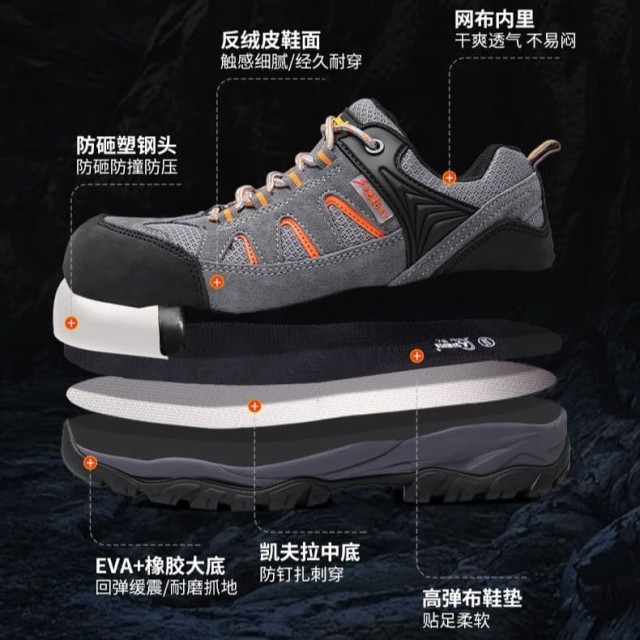When workplace hazards demand reliable foot protection, the choice between composite and steel toe materials impacts safety compliance, long-term comfort, and operational costs. This guide compares both options across critical factors—from impact resistance to electrical hazard ratings—helping safety managers and procurement specialists make informed decisions.
Safety Priorities by Work Environment
Impact Resistance in Heavy Industrial Settings
Steel toe caps excel in environments with crushing hazards (e.g., construction, manufacturing), offering superior protection against heavy falling objects. Research confirms steel’s structural integrity under extreme compression, while composite materials may degrade faster under repeated high-impact loads.
Key Consideration: For industries like mining or logistics where equipment collisions are frequent, steel toes provide a proven safeguard.
Electrical Hazard Ratings Explained
Both materials meet ASTM F2413 standards for electrical hazard (EH) resistance, but composite toes inherently insulate against live circuits—making them preferable for electricians or utility workers. Steel toes can conduct electricity unless specially insulated.
Compliance Tip: Verify EH-rated designs explicitly, as non-insulated steel toes risk grounding currents in wet conditions.
Comfort and Long-Term Wearability
Weight Comparison for Shift Workers
Composite toes weigh significantly less (often under half the weight of steel), reducing fatigue for employees standing 8+ hours. Warehousing and healthcare sectors report higher adoption of composite designs for this reason.
Ergonomic Design Differences
Composite materials allow for sleeker, more flexible toe boxes, accommodating wider feet or orthotic inserts. Steel toes may restrict natural foot movement, potentially causing discomfort during prolonged use.
User Insight: Workers in dynamic roles (e.g., aviation ground crews) often prioritize composite for mobility.
Environmental Durability Factors
Heat Exposure Limits for Composite Materials
Composite toes withstand temperatures up to moderate ranges (~300°F), but prolonged heat (e.g., foundry work) can warp the material. Steel toes tolerate higher heat without structural compromise.
Corrosion Risks in Humid or Chemical Environments
Steel is prone to rust in humid or salt-rich settings (e.g., offshore drilling), whereas composite resists corrosion. Chemical exposure (e.g., oil refineries) also favors composite’s non-reactive properties.
Maintenance Note: Regular drying and anti-corrosion treatments extend steel toe lifespan in harsh climates.
Compliance and Cost Considerations
ASTM F2413 Standards Breakdown
Both materials pass ASTM compression tests (e.g., 2,500 lbs), but steel toes typically exceed minimum thresholds for puncture resistance. Ensure footwear labels specify compliance with your industry’s ASTM codes (e.g., I/75/C/75 for impact, compression, and metatarsal protection).
Warranty Benchmarks by Industry
Steel toe boots often feature longer warranties (3+ years) due to material durability, while composite designs average 1–2 years. Bulk buyers should weigh replacement cycles against upfront costs.
Procurement Strategy: High-turnover industries (e.g., food processing) may favor composite for cost efficiency, while heavy industry invests in steel’s longevity.
Upgrade Your Safety Footwear Strategy with 3515
Whether you supply composite toes for electrical safety or steel toes for heavy industry, 3515’s manufacturing expertise ensures OSHA-compliant footwear tailored to your clients’ needs. Partner with us to equip workers with protection that balances safety, comfort, and value—request a catalog today to explore customizable bulk solutions.
Products You Might Be Looking For:
View heavy-duty steel toe work shoes
Explore OSHA-compliant steel toe footwear
Browse customizable safety shoes for industry
Related Products
- Wholesale Customizable Suede Safety Boots - Puncture-Proof with Velcro Closure
- Puncture-Resistant Velcro Safety Boots for Wholesale & Custom Manufacturing
- Wholesale Slip-On Safety Boots Manufacturer - Custom Puncture-Proof & Steel Toe
- Athletic Safety Shoes with Dial Closure & Steel Toe for Wholesale & Custom Manufacturing
- Wholesale Mesh Steel Toe Safety Shoes with Dial Closure Factory Production
Related Articles
- Work Boots vs. Western Boots: How to Choose the Right Footwear for Labor Safety
- How to Extend Work Boot Lifespan: Science-Backed Care for Safety & Savings
- How to Choose Work Boots That Match Your Job's Safety Demands
- How to Choose Work Boot Materials for Maximum Safety and Durability
- Matching Men’s Work Shoe Safety Technologies to Workplace Hazards



















